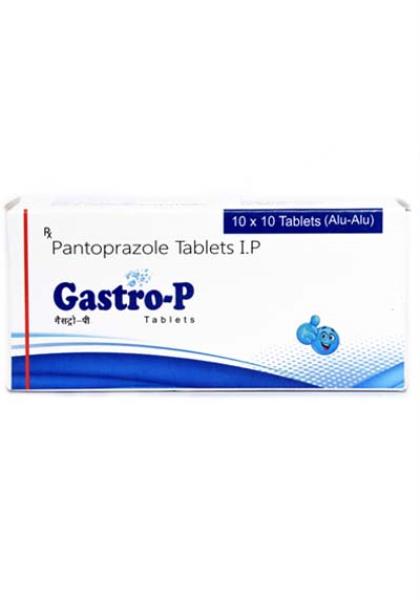Setting Standards Across the Pharma Value Chain

(PANTAPRAZOLE 40)
M.R.P RS 79/10TAB
What is pantoprazole?
Pantoprazole is a proton pump inhibitor that decreases the amount of acid produced in the stomach.
Pantoprazole is used to treat erosive esophagitis (damage to the esophagus from stomach acid), and other conditions involving excess stomach acid such as Zollinger-Ellison syndrome
Pantoprazole is not for immediate relief of heartburn symptoms.
Important Information:
Pantoprazole is not for immediate relief of heartburn symptoms.
You should not use this medication if you are allergic to pantoprazole or to any other benzimidazole medication such as albendazole (Albenza), or mebendazole (Vermox).
Call your doctor at once if you have symptoms of a serious side effect: decreased urination, blood in your urine, severe stomach pain, watery or bloody diarrhea, or new or worsening symptoms of joint pain or a skin rash that worsens in sunlight.
Pantoprazole may increase your risk of bone fracture in the hip, wrist, or spine, especially if you take this medicine long term or at high doses.
Heartburn is often confused with the first symptoms of a heart attack. Seek emergency medical attention if you have chest pain or heavy feeling, pain spreading to the arm or shoulder, nausea, sweating, and a general ill feeling.
Take pantoprazole for the full prescribed length of time. Your symptoms may improve before the condition is fully treated.
Pantoprazole should not be taken together with atazanavir (Reyataz) or nelfinavir (Viracept). Tell your doctor if you are taking either of these medications to treat HIV or AIDS.
Some conditions must be treated long-term with pantoprazole. Chronic use has caused stomach cancer in animal studies, but it is not known if this medication would have the same effects in humans. Talk with your doctor about your specific risk of developing stomach cancer.
Long-term treatment with pantoprazole may also make it harder for your body to absorb vitamin B-12, resulting in a deficiency of this vitamin. Talk with your doctor if you need long-term pantoprazole treatment and you have concerns about vitamin B-12 deficiency.
Before taking this medicine:
Heartburn is often confused with the first symptoms of a heart attack. Seek emergency medical attention if you have chest pain or heavy feeling, pain spreading to the arm or shoulder, nausea, sweating, and a general ill feeling.
You should not use this medicine if:
To make sure pantoprazole is safe for you, tell your doctor if you have:
Taking a proton pump inhibitor such as pantoprazole may increase your risk of bone fracture in the hip, wrist, or spine. This effect has occurred mostly in people who have taken the medicine long term or at high doses, and in those who are age 50 and older. It is not known whether this medicine will harm an unborn baby. Tell your doctor if you are pregnant or plan to become pregnant. Pantoprazole can pass into breast milk and may harm a nursing baby. You should not breast-feed while using this medicine. Pantoprazole is not approved for use by anyone younger than 5 years old.
How should I take pantoprazole?
Common
Take pantoprazole exactly as prescribed by your doctor. Follow all directions on your prescription label. Do not take this medicine in larger or smaller amounts or for longer than recommended.
Pantoprazole tablets can be taken with or without food. Pantoprazole oral granules should be taken 30 minutes before a meal.
Do not crush, chew, or break the tablet. Swallow it whole.
The oral granules should be mixed with applesauce or apple juice. Do not use any other type of liquid or soft food. Sprinkle the granules directly onto 1 teaspoon of applesauce or apple juice. Stir for 5 seconds and swallow this mixture right away without chewing. Do not save the mixture for later use.
To give pantoprazole granules through a nasogastric (NG) feeding tube:
Take this medicine for the full prescribed length of time. Your symptoms may improve before the condition is fully treated.
If you use pantoprazole for longer than 3 years, you could develop a vitamin B-12 deficiency. Talk to your doctor about how to manage this condition if you develop it.
Call your doctor if your symptoms do not improve or if they get worse while you are taking this medicine.
If you use pantoprazole for longer than 3 years, you could develop a vitamin B-12 deficiency. Talk to your doctor about how to manage this condition if you develop it.
This medicine can cause you to have a false positive drug screening test. If you provide a urine sample for drug screening, tell the laboratory staff that you are taking pantoprazole.
Store at room temperature away from moisture and heat.
Pantoprazole side effects.
Get emergency medical help if you have signs of an allergic reaction to pantoprazole: hives; difficulty breathing; swelling of your face, lips, tongue, or throat.
Call your doctor at once if you have:
Common pantoprazole side effects may include: